The Jewel Orchid or Ludisia discolor is unlike all other Orchids we grow in our homes because as a houseplant the Jewel Orchid is prized for its foliage rather than its flowers.
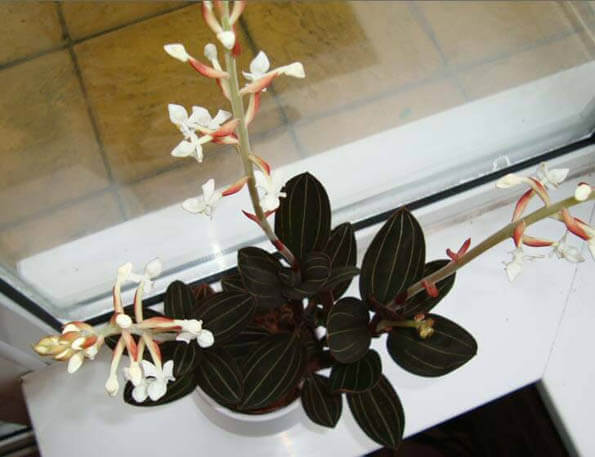
The Jewel Orchid is an eye catching houseplant
This is a simple and easy indoor plant to care for. A mature Jewel Orchid that is several years old and has received good care will eventually produce multiple growths and spread out.
TIP - Although the flowers are quite basic, they will still add more visual interest to your plant compared to the many other houseplants which are grown for their foliage alone.
When it's time for the plant to flower, the growths will each produce a flowering spike that grows upwards quickly. Once ready the flower buds will open and show off many little white flowers which certainly create a lasting impression.
Unfortunately, the plant itself and the flowers are not show-stoppers, so they're easily overlooked in stores when compared to its cousins such as the Moth and Cambria Orchids. But it has a contemporary and unusual charm that can appeal to those who chance upon them.
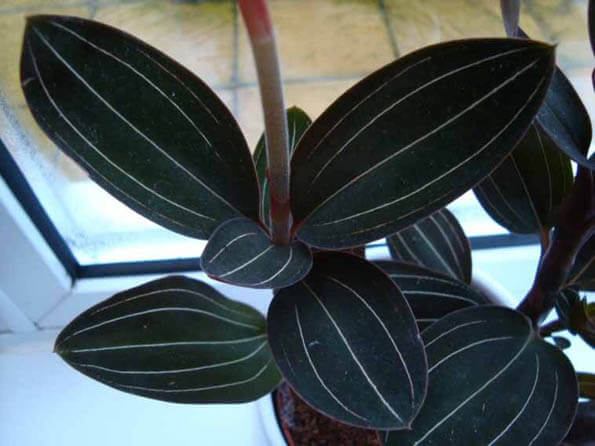
The white pinstripe markings pop against the contrasting dark leaves
Bizarrely, unlike its cousins, the Jewel Orchid is easy to propagate and grows to a large saleable size quickly. But sellers will often still demand quite a lot of money which could be another reason why the Jewel Orchid's popularity hasn't taken off.
However, if you're keen on a bargain you could be in luck. Its discreet appearance means it's normally only sold when in flower, presumably as this little extra flourish commands that extra attention to draw the eye. So as the flowers start to go over, or at other times of the year, sellers often discount heavily to shift their remaining stock.
TIP - Be bold and put these plants in a contrasting pot. It will help make the leaves stand out even more.
There are just two types of Ludisia Orchids that are commonly sold. The first is the "Black Jewel Orchid" (see photos above) and this has very dark deep green leaves, almost black looking, with fine white pinstripe markings.
In certain light, the maroon coloring underneath the leaves can shine through and turn the white lines a hue of red. Of the two, it's arguable the more popular and commonly found.
The second type is "Ludisia Discolor Alba" (pictured just below). Although rarer, it's more modern and certainly has some serious fans, with many plant hunters searching them out. The Alba has medium green leaves with silver "veins" running through a good proportion of the leaf.
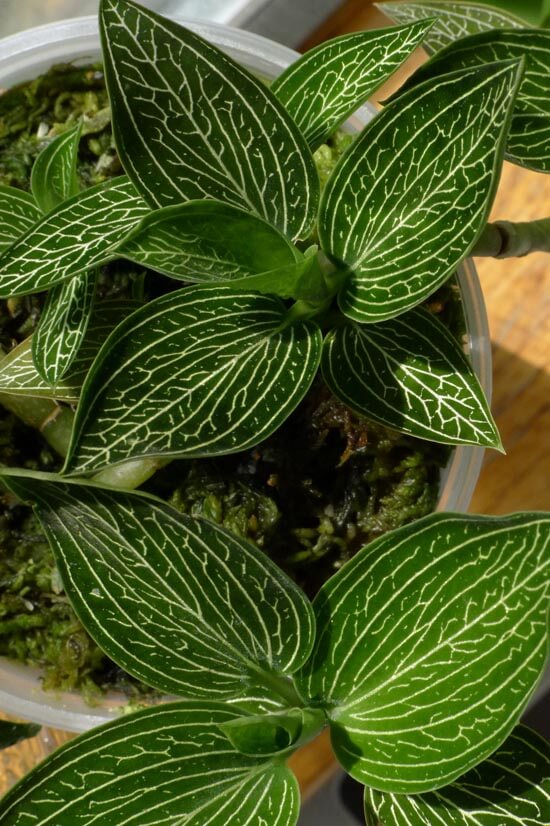
Ludisia Discolor Alba - photo taken by chipmunk_1
The Lightning Bolt Jewel Orchid (Macodes petola) is not the same species as the Jewel Orchids covered in this article (Ludisia). Again it has remarkable looking leaves, in this case, it has veins like lightning bolts. However, it's much smaller and does not grow as fast.
Whether you pick up the Black Jewel Orchid or the Alba, they both have easy going natures and get our seal of approval. It's a good houseplant for you to consider growing in your home and with the introduction out of the way, next, we're going to cover the care instructions so you're know how to keep them alive.

Hi, I'm Tom!
If you're like me and enjoy the challenge of growing houseplants and getting them to thrive, then Ourhouseplants can help. This website shares my knowledge and years of growing plants and provides (hopefully) helpful advice on properly caring for your indoor plant friends.
Out in its natural habitat, the Jewel Orchid is found growing down low, often in pretty shady places. For the best results try to replicate this in your home or office by avoiding placing it in direct sunlight.
North facing rooms are perfect, but any other facing aspect is fine providing you can shield the leaves from any harsh sunlight that filters through during the day. Do not mistake this as a plant which likes darkness though, deep gloom should be avoided as much as direct sunlight otherwise it won't grow.
For the majority of the time slightly damp conditions are what the Jewel Orchid wants to grow in
For the majority of the time slightly damp conditions are what the Jewel Orchid wants to grow in. It doesn't like having bone dry soil, but equally, it hates soaking wet soil, leave its roots sitting in water and it will rapidly die.
Water the plant well and then wait until it's drying out before watering again. A good rule of thumb is to wait until the top inch is dry before giving more water. If you're using a more porous potting mix it will dry out quicker so you'll need to water more often than if using standard potting soil.
If you need a little more guidance, I have a separate post that includes a quiz that asks about your growing environment and it will then help work out how often you should water your orchid plant.
If you get the watering requirements perfect, humidity is of only minor importance. If you know you're quite bad when it comes to watering though, give your Jewel Orchid a helping hand by increasing the surrounding humidity. This will give your plant a small buffer to compensate for the care you provide.
They do look lovely and thrive in Bottle Gardens but don't bother if you're keen on making it flower. This is because the blooms spoil quickly in the very moist environments that Bottle Gardens create.
Jewel Orchids are small feeders, so in reality you'll be totally fine if you only fed your plant a few times a year. You can use a special orchid feed or something more generic, it's not overly fussy.
TIP - Not too hot. Not too cold. These plants do best in average room temperatures.
If you're feeling cold then your Jewel Orchid is probably feeling the same. The lowest temperature that we'd risk is 10°C (50°F). They also don't like very hot spots in your home so avoid placing near working radiators or heaters.
Repot your Ludisia when the pot is overcrowded or if it starts to become wobbly and top-heavy. These orchids tend to spread out rather than grow tall, so their roots don't need a deep pot. Instead where you can opt for a shallow and wide pot.
Unlike a lot of orchids, you can use normal potting compost but you need to be careful with the plants watering requirements to avoid overwatering. Normal potting soil is designed to hold on to water so if you accidentally saturate the soil this saturation stays around for quite a while and drastically increases the possibility of rotting.
TIP - Don't use "Orchid Compost" that contains high volumes of bark. This stuff is only designed for true Orchids plants.
If you don't feel comfortable or confident using potting compost then the alternative is to use a much more porous soil mix, for example 60% potting soil and 40% grit or Perlite etc. A small amount of orchid bark is acceptable in place of grit but is far too lose to hold much water so you shouldn't use a high amount of bark unless you're happy to water every couple of days.
The actual repotting is easy enough because it's the same method you would use for any other houseplant. We've linked to a YouTube video below that we quite like if you want to see the repotting process visually.
Click the image above to watch a Jewel Orchid repotting video
The stems are quite brittle and can easily break when you handle the Jewel Orchid so it's common to propagate through stem cuttings when you are repotting the main "cluster".
Nothing special is needed, once you have a piece of stem with upper leaves pot it up into a similar potting mix as the parent. New roots should develop within a month or two, be careful until this happens as the new plant won't be well anchored into whatever growing media you've chosen, so it can be knocked out easily.
In Spring and Summer, the Jewel Orchid grows rapidly if light levels are decent. In poor light and Winter, the growth slows down.
The growth habit of these orchids is to spread rather than grow for height, so often they're wider than they are tall. The flowering stem can double or almost triple the height of the plant.
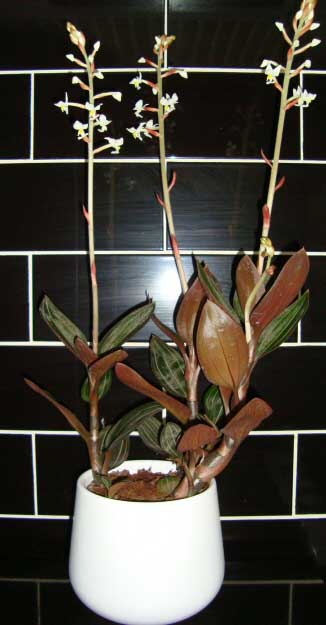
When in flower the plant can double in height
Large flowering spikes shoot out of tops of the plant stems in Autumn / Fall and Winter. Providing good light and correct care has been received during the growing season.
Some people cut them off when the buds start to form as they're not considered to better the foliage in terms of appearance. However, they're still dainty and pretty, with their small numerous white flowers with yellow centers. If the temperature isn't too warm they should last a few weeks up to a month.
Unlike some Orchids, the Jewel Orchid is not toxic to pets or people.
If you are passionate about the foliage of Ludisia discolor and don't care about the flowers, pinch out the flowering spikes when they start to form. This encourages the plant to remain compact and bushy, producing more leaves whereas allowing the flowering to take place can encourage the plant to become leggy.
Medium Light Levels Not overly fussy, but you need to avoid bright direct sunlight and dark low light gloom.
Moderate Watering Water well and then don't water again until the top of the potting mix has dried out. Much less water needed in Winter.
Temperature Warm rooms are needed as they don't like the cold. Between 16°C (61°F) - 22°C (72°F).
Feeding Two or three times a year is enough.
Rotting Stems (Basal Stem Rot), mushy leaves.
Although adaptable to our homes and quite easy going, too much water for too long will lead to destructive rotting of the stems and roots. This can also be caused by very cold temperatures. Once rot sets in your have a serious problem as its very difficult to reverse. Cut off the rotten bits if it's only minor, otherwise try to salvage what you can through propagation.
No Flowers.
Young, sickly, or plants that are grown in low light conditions will all have a flowering issue in the sense that there won't be any. Jewel Orchids need to be mature, healthy and grown in a reasonable level of light before they flower.
Shriveled leaves and stems.
This is typically a symptom of not watering enough.
Leaves are crispy or becoming lighter.
Direct sunlight won't finish off your plant, but it can damage the appearance of the leaves. Too much light can cause the leaves to scorch or force the plant to adapt to all this light by reducing the amount of chlorophyll found in its leaves which can give a washed out look.
White Mold / Mould.
This can affect the soil of any houseplant, simply because at times it's difficult to provide good ventilation indoors. It can be particularly bad on plants that cluster and naturally shield the soil with their stems and leaves, combined with their spreading habit which is how the Jewel Orchid grows.
If you have a white mold problem have a read of our disease article.
Jewel Orchids as individual plants are pretty looking. When it flower they can draw the eye and make super talking points. But when clustered with other houseplants they're all to often hidden and missed.
This was my experience for many years, whenever browsing plants in a store they'd get a quick look before I'd move onto something else. Something more colorful, bigger, or just more unusual looking. You get the idea I'm sure!
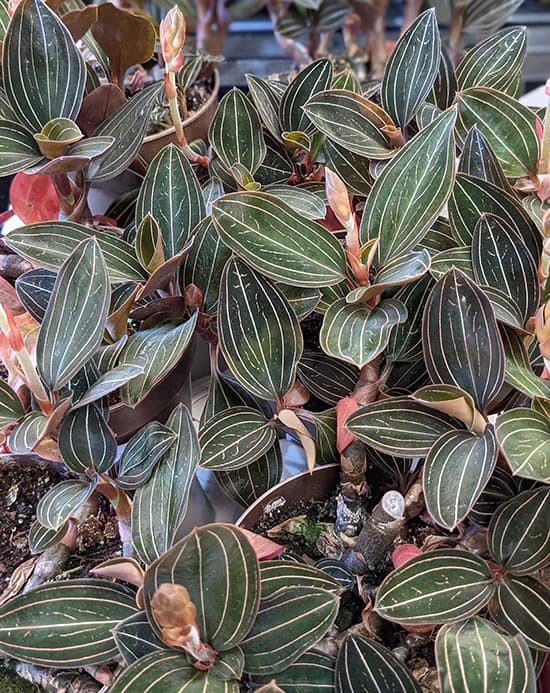
When they're not flowering, Jewel Orchids can blend in and are easily overlooked for more bold looking houseplants.
Anyway one Winter I was shopping in a store where someone has put six or so flowering plants into a long galvanized metal container and the look was breathtaking. How could I have avoided these houseplants for so many years when they look like this!
The shop Assistant saw me looking and told me they were super easy to look after. Knowing that in general Orchids can sometimes be fussy and short-lived, I remember giving her a skeptical look. She wasn't one to give up and assured me this wasn't like a normal orchid and it would be fine. I brought one and she was absolutely right.
It was super easy to look after and I had it a good five years before I gave it away to a friend. The Alba isn't popular around here yet, but when I find one I will be giving that a go next.
(Article) Ludisia discolor alba photo by chipmunk_1